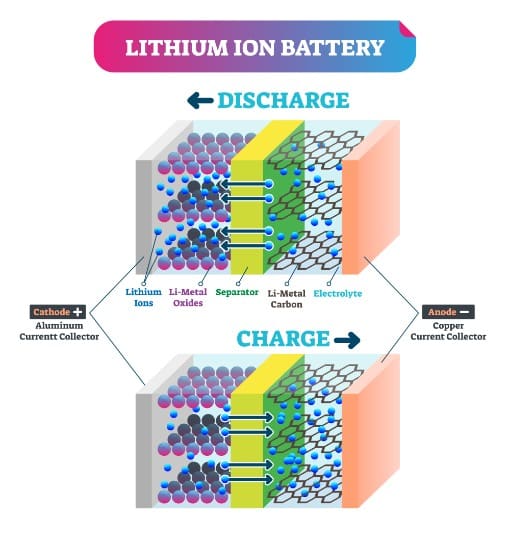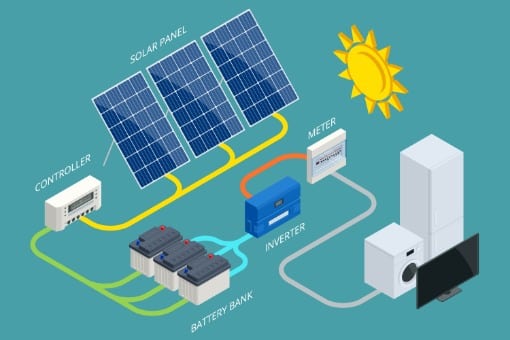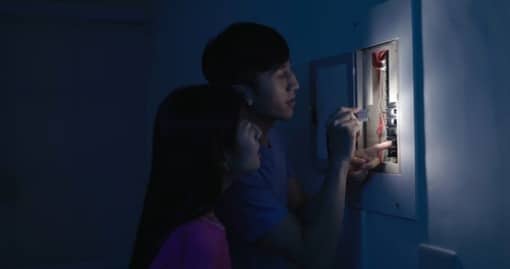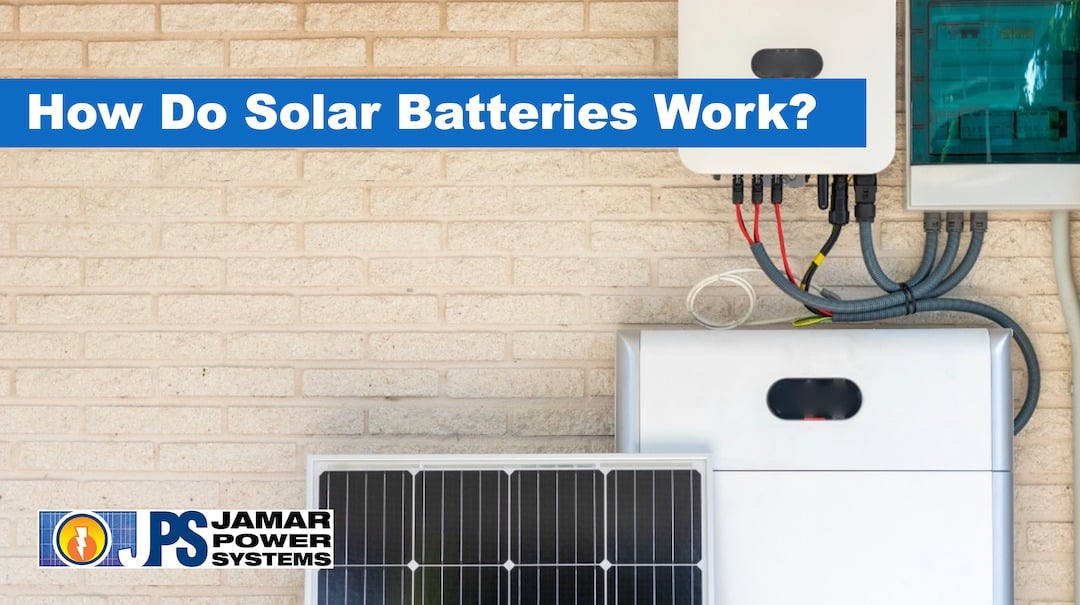How Solar Batteries Work: A Comprehensive Guide for Homeowners
Welcome to the world of solar energy!
As more homeowners seek sustainable and cost-effective solutions for their energy needs, the popularity of solar power continues to soar.
One of the key components of a solar energy system is the solar battery, which plays a crucial role in storing excess energy generated by solar panels or from charging using utility power during off-peak hours (known as peak-shaving).
How Batteries Store Energy
Before delving into the specifics of solar batteries, let’s first understand the fundamental principles of energy storage.
Batteries function as reservoirs for electrical energy, allowing it to be stored and discharged as needed.
Whether it’s a flashlight battery or a sophisticated lithium-ion cell, the basic concept remains the same – the conversion of chemical energy into electrical energy and vice versa.
Lithium-ion batteries have emerged as the preferred choice for solar energy storage due to their high energy density, efficiency, and longevity.
Lithium-ion batteries offer greater storage capacity and faster charging times than traditional lead-acid batteries, making them ideal for residential solar applications.
In this comprehensive guide, we will explore how solar batteries work, their integration into solar power systems, their use without solar power systems, and the various modes in which they operate to provide homeowners with reliable and efficient energy solutions that can ultimately save them money.

How Lithium-ion Batteries Work
Lithium-ion batteries operate on a simple yet sophisticated mechanism.
At their core are electrodes – one positively charged (cathode) and one negatively charged (anode) – separated by an electrolyte solution.
During charging, lithium ions migrate from the cathode to the anode through the electrolyte, storing energy in the process.
When discharging, the ions flow back to the cathode, generating an electrical current that can be used to power appliances and devices.
The chemistry behind lithium-ion batteries, typically involving lithium cobalt oxide, lithium iron phosphate, or other lithium-based compounds, determines their performance characteristics.
These batteries are known for their high energy density, low self-discharge rates, and minimal maintenance requirements, making them an ideal choice for solar energy storage.

How Does A Solar Battery Power Your Home?
Now that we understand the basics of energy storage and lithium-ion battery technology let’s explore how solar batteries power your home.
In a typical solar energy system, solar panels mounted on the roof or in the yard harness sunlight and convert it into electrical energy. This energy is used directly to power appliances or stored in a solar battery for later use.
During periods of peak sunlight, such as midday, solar panels produce more energy than is immediately needed by the home. Excess energy is diverted to the solar battery for storage in such cases.
Later, when energy demand exceeds solar generation, the stored energy is discharged from the battery, supplementing or replacing grid-supplied electricity.
Solar batteries play a crucial role in maximizing the self-consumption of solar energy, allowing homeowners to reduce their reliance on the grid and potentially lower their electricity bills.
Additionally, solar batteries provide a reliable backup power source during grid outages, ensuring uninterrupted electricity supply for essential appliances and devices.
How Solar Batteries Work With A Solar Power System
Integrating solar batteries into a solar power system is seamless and straightforward.
Typically, a solar inverter is responsible for converting the direct current (DC) electricity generated by solar panels into alternating current (AC) electricity suitable for use in the home.
In systems equipped with solar batteries, a charge controller or battery management system regulates the flow of energy between the solar panels, batteries, and the home’s electrical system.
During periods of excess solar generation, the charge controller directs surplus energy to the batteries for storage.
Conversely, when solar generation is insufficient to meet demand, the controller draws energy from the batteries to supplement the shortfall.
This dynamic energy management ensures efficient utilization of solar resources while providing reliable backup power when needed.
Advancements in solar power technology, such as smart inverters and integrated battery management systems, have made it easier than ever for homeowners to harness the full potential of solar energy.
With the ability to monitor energy production and consumption in real time, homeowners can optimize their solar power systems for maximum efficiency and cost savings.

How Does a Solar Battery Work in Critical Backup Mode?
For homeowners concerned about grid reliability or living in areas prone to power outages, solar batteries offer an invaluable solution in the form of critical backup mode.
In this mode, solar batteries are configured to prioritize the supply of power to essential loads, such as refrigerators, lights, and communication devices, during grid outages.
When the grid goes down, the solar battery automatically switches to backup mode, ensuring that critical loads remain powered until grid power is restored or renewable energy generation resumes.
Advanced battery management systems allow homeowners to customize backup settings and monitor battery status remotely, providing peace of mind in times of emergency.
No solar panels are needed for a battery storage system to provide emergency backup power during a power outage.
The reliability and capacity of solar batteries are critical factors to consider when planning for backup power.
Homeowners should assess their energy needs and choose a battery system with sufficient capacity to support essential loads for the desired duration of backup operation.
Additionally, regular maintenance and testing of the backup system are essential to ensure its readiness when needed most.

How Does A Solar Battery Work in Solar Self-Consumption Mode?
In addition to providing backup power during outages, solar batteries allow homeowners to maximize self-consumption of solar energy through dedicated self-consumption mode.
In this mode, solar batteries are programmed to prioritize storing solar energy over grid-supplied electricity, thereby reducing reliance on the grid and lowering electricity bills.
During periods of peak solar generation, excess energy is stored in the solar battery for later use rather than being exported to the grid.
As energy demand increases or solar generation decreases, the battery seamlessly supplements grid power, allowing homeowners to maintain consistent self-sufficiency.
Solar self-consumption mode is particularly beneficial for homeowners with time-of-use electricity pricing or net metering arrangements, where the value of exported solar energy may be lower than the cost of grid electricity.
By maximizing self-consumption, homeowners can optimize their solar power systems for maximum financial savings and environmental impact.

What Happens to the Solar Power Being Produced When the Batteries Are Full?
One common question among homeowners considering solar batteries is what happens to excess solar power when the batteries are fully charged.
In most cases, surplus solar energy is either exported to the grid or curtailed to prevent overcharging of the batteries.
Many utility companies offer net metering programs that allow homeowners to receive credit for excess solar energy exported to the grid, effectively offsetting future electricity bills.
Alternatively, some homeowners may choose to divert excess solar energy to other uses, such as charging electric vehicles, to further enhance the efficiency and sustainability of their energy systems.
Key Takeaways:
Solar batteries play a crucial role in maximizing the efficiency, reliability, and cost-effectiveness of solar power systems for homeowners.
Lithium-ion batteries offer superior performance and longevity compared to traditional lead-acid batteries, making them an ideal choice for solar energy storage.
Solar batteries can operate in various modes, including critical backup mode and solar self-consumption mode, to meet the diverse needs of homeowners.
Integration of solar batteries into solar power systems is seamless and straightforward, thanks to advancements in technology and battery management systems.
By optimizing self-consumption of solar energy and leveraging backup power capabilities, homeowners can reduce their reliance on the grid and enjoy greater energy independence.
Conclusion:
As the demand for renewable energy solutions continues to grow, solar batteries are poised to play an increasingly important role.
Investing in a solar power system with integrated battery storage is a smart and forward-thinking decision for homeowners looking to save money on electricity, enhance their resilience to power outages, and reduce their carbon footprint.
With the right combination of technology, planning, and expertise, homeowners can harness the full potential of solar energy to power their homes reliably and sustainably for years to come.
If you’d like to see if solar batteries are right for your household, contact us for a FREE solar battery analysis and quote.
Related articles:
2025 Federal tax credit changes for solar & solar batteries
Solar panel monitoring service
Battery storage system fundamentals
Peak Shaving: Invest in your home’s energy future for significant ROI
Why a battery makes financial sense with solar panels now under NEM 3.0
How long will a solar battery last during a power blackout?
How many batteries are needed to power your home?
How many years do solar batteries last?
Solar Battery or generator for emergency backup power?
How to check if your solar panels are charging the solar battery
Complete Guide to Solar PPA, Lease vs Buying Solar
How to choose a solar installer
Get a FREE solar anaylsis to see if solar energy or a battery is right for your home
- 2025 Federal Tax Credit Changes For Solar Panel Systems & Solar Batteries - July 8, 2025
- How Solar Batteries Work - March 4, 2024
- Solar Battery or Generator for Emergency Backup Power? - January 30, 2024



